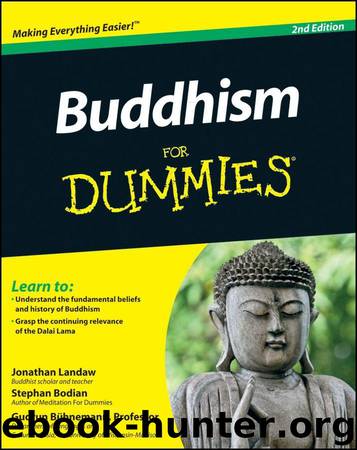Buddhism For Dummies by Landaw Jonathan & Bodian Stephan & Bühnemann Gudrun

Author:Landaw, Jonathan & Bodian, Stephan & Bühnemann, Gudrun [Landaw, Jonathan]
Language: eng
Format: azw3
Publisher: Wiley
Published: 2011-07-06T16:00:00+00:00
If you’re a serious Zen student but can’t practice at the center, because you’re sick, you live too far away, or you can’t arrange your calendar to include it, you can generally follow some version of this daily schedule on your own by sitting in the morning and again, if possible, in the evening. Then to energize and deepen your practice, you can make it a point to attend one or more intensive retreats each year.
Attending silent retreats
Most Zen centers in the West offer regular one- to seven-day retreats (Japanese: sesshin) featuring as many as a dozen periods of meditation each day, morning and evening services, daily talks on Buddhist themes, and interviews. (Korean Zen also offers retreats devoted primarily to chanting and bowing.) As a rule, these rigorous retreats are held in silence and offer an opportunity to hone your concentration, deepen your insight into the fundamental truths of Buddhism, and possibly catch a glimpse of your essential Buddha nature (an experience of awakening known in Japanese as kensho or satori). Retreats of more than one or two days are generally residential, though some centers allow you to attend part time while continuing your everyday life.
Jukai: The bodhisattva initiation or lay ordination
Jukai (Japanese: “receiving the precepts”) is the ceremony of a layperson’s ordination or formal entry into the practice of the bodhisattva precepts in the Zen tradition. This ceremony involves making a commitment to practice and keep the precepts for life while being a householder. In many American Zen centers, including the San Francisco Zen Center, the ceremony is a shortened version of Zaike Tokudo (“staying at home and attaining the way”). To prepare, a candidate sews a rakusu, a five-panel small robe patterned after the Buddha’s robe, and studies the bodhisattva precepts (see Chapter 6).The ceremony then starts with an invocation to all Buddhas and bodhisattvas, to provide a framework of support for the candidates’ initiation. Each candidate receives a new name and the robe he has sewn. The candidates then formally don the rakusu with a chant. Next, they avow and repent past actions stemming from greed, anger, and ignorance, and are purified with water. Thus purified, they receive the 16 precepts by reciting them after the teacher (see the following figure of a lay Buddhist ordination at the City Center in San Francisco). They receive the bloodline of the Buddhas and ancestors (Japanese: kechimyaku). Finally, the teachers give congratulatory statements, and the ceremony is dedicated to the welfare of all beings.
Download
This site does not store any files on its server. We only index and link to content provided by other sites. Please contact the content providers to delete copyright contents if any and email us, we'll remove relevant links or contents immediately.
The Way of Zen by Alan W. Watts(6461)
Ego Is the Enemy by Ryan Holiday(5245)
The Art of Happiness by The Dalai Lama(4016)
The Book of Joy by Dalai Lama(3863)
Why Buddhism is True by Robert Wright(3379)
Spark Joy by Marie Kondo(3197)
Shift into Freedom by Loch Kelly(3103)
Happiness by Matthieu Ricard(2967)
A Monk's Guide to a Clean House and Mind by Shoukei Matsumoto(2847)
The Lost Art of Good Conversation by Sakyong Mipham(2511)
The Meaning of the Library by unknow(2477)
The Unfettered Mind: Writings from a Zen Master to a Master Swordsman by Takuan Soho(2208)
The Third Eye by T. Lobsang Rampa(2207)
Anthology by T J(2129)
Red Shambhala by Andrei Znamenski(2123)
The Diamond Cutter by Geshe Michael Roach(1999)
Thoughts Without A Thinker: Psychotherapy from a Buddhist Perspective by Epstein Mark(1944)
Twilight of Idols and Anti-Christ by Friedrich Nietzsche(1811)
Advice Not Given by Mark Epstein(1800)
